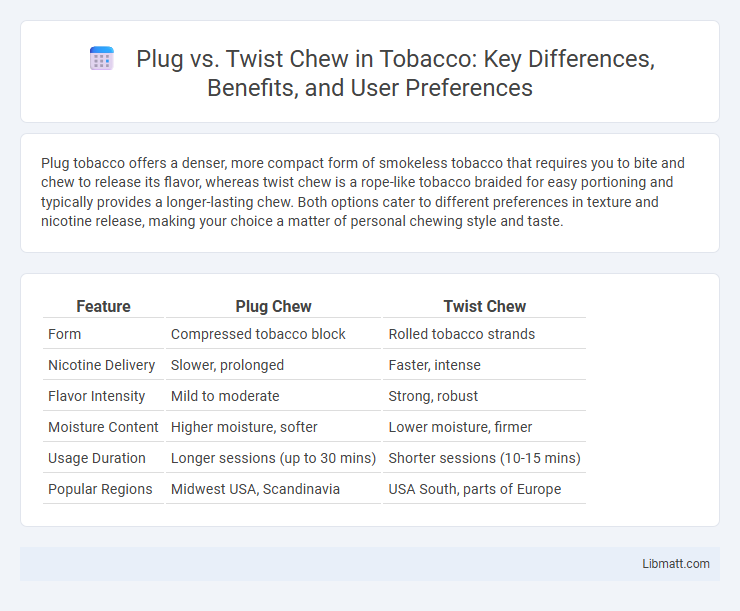Plug tobacco offers a denser, more compact form of smokeless tobacco that requires you to bite and chew to release its flavor, whereas twist chew is a rope-like tobacco braided for easy portioning and typically provides a longer-lasting chew. Both options cater to different preferences in texture and nicotine release, making your choice a matter of personal chewing style and taste.
Table of Comparison
| Feature | Plug Chew | Twist Chew |
|---|---|---|
| Form | Compressed tobacco block | Rolled tobacco strands |
| Nicotine Delivery | Slower, prolonged | Faster, intense |
| Flavor Intensity | Mild to moderate | Strong, robust |
| Moisture Content | Higher moisture, softer | Lower moisture, firmer |
| Usage Duration | Longer sessions (up to 30 mins) | Shorter sessions (10-15 mins) |
| Popular Regions | Midwest USA, Scandinavia | USA South, parts of Europe |
Introduction to Plug vs Twist Chew
Plug and twist chew are two popular forms of smokeless tobacco differing in texture and usage. Plug chew is composed of tobacco leaves pressed into a solid block, requiring the user to bite off pieces, while twist chew is rolled tobacco leaves twisted into strands for easier portioning. Understanding these distinctions helps you choose the product that best suits your preference and chewing experience.
Historical Background of Plug and Twist Chew
Plug and twist chew trace their origins to the early 19th century when Native American tribes introduced chewing tobacco to European settlers. Plug tobacco, characterized by its compressed, brick-like form, became popular in the mid-1800s due to its convenience and longer-lasting flavor. Twist chew, originating from the same era, involves tobacco leaves twisted into rope-like strands, offering a traditional hand-rolled alternative favored for its portability and slow burn.
Key Differences Between Plug and Twist Chew
Plug chew consists of a solid block of tobacco pressed tightly together, offering a slow, consistent burn and long-lasting flavor. Twist chew features strands of tobacco twisted into a rope-like form, providing a stronger nicotine hit and a more intense, quicker flavor release. Both differ in texture, nicotine delivery, and consumer experience, with plug chew favored for prolonged use and twist chew chosen for stronger immediate effects.
Manufacturing Processes: Plug vs Twist Chew
Manufacturing plug chew involves compressing tobacco leaves into a dense, rectangular block, while twist chew is created by rolling and twisting whole tobacco leaves into a compact cylinder. The plug method requires precise moisture control and pressing techniques to ensure consistency, whereas twist chew relies more on careful leaf selection and manual rolling or mechanical twisting for its shape. Your choice between the two depends on preferences for texture, flavor release, and production style.
Flavor Profile Comparison
Plug tobacco delivers a rich, intense flavor with deep, earthy undertones and a slightly sweet finish, ideal for smokers seeking a robust experience. Twist chew offers a milder taste featuring a natural tobacco sweetness blended with subtle hints of spice and fruitiness, making it smoother and more approachable. Flavor preferences vary widely, with plug favored for its boldness and twist chew appreciated for its balanced, nuanced profile.
User Preferences and Experience
User preferences between plug and twist chew products vary based on texture and nicotine delivery methods, with plug chew offering a denser and longer-lasting tobacco experience. Twist chew provides a softer, more pliable texture favored by users seeking a milder flavor release and quicker nicotine absorption. The choice largely depends on individual taste preferences, desired nicotine strength, and chewing duration, influencing overall satisfaction and use patterns.
Health Considerations and Risks
Plug tobacco and twist chew both pose significant health risks, including increased chances of oral cancer, gum disease, and tooth decay due to prolonged exposure to harmful chemicals and nicotine. Plug tobacco often contains higher nicotine levels, intensifying addiction potential and cardiovascular strain. Your decision to use either should consider these serious health implications and the difficulty of quitting due to strong dependence factors.
Market Trends and Popular Brands
The plug and twist chew market exhibits steady growth driven by increasing consumer preference for smokeless tobacco alternatives. Popular brands in the plug chew segment include Levi Garrett and Red Man, known for their dense, moist texture favored in the Southern U.S. Twist chew products, with brands like Beech-Nut and Stoker's, cater to niche consumers seeking flavored, hand-rolled tobacco options. Market trends indicate a rising demand for organic and natural ingredients, pushing brands to innovate with healthier formulations and attractive packaging.
How to Choose: Plug or Twist Chew
Selecting between plug and twist chew depends on personal preference and usage style; plug chew offers a firm, dense texture ideal for sustained flavor release, while twist chew provides a looser, more malleable form allowing easier portions and quicker nicotine absorption. Consider the strength and flavor intensity, as plug chew tends to contain higher nicotine levels and richer taste profiles, making it suitable for those seeking a stronger experience. For convenience and portability, twist chew's compact, pliable design suits users who prefer discreet and fast consumption.
Future Outlook for Chewing Tobacco Products
The future outlook for chewing tobacco products shows a gradual decline in traditional plug and twist forms as consumer preferences shift towards smokeless alternatives like nicotine pouches and dissolvable tobacco. Market trends indicate increased regulatory pressures and health awareness are pushing manufacturers to innovate and diversify their product lines with reduced-risk options. Continued investments in research and development are expected to drive the evolution of chewing tobacco products, focusing on enhanced user experience and harm reduction.
plug vs twist chew Infographic

 libmatt.com
libmatt.com